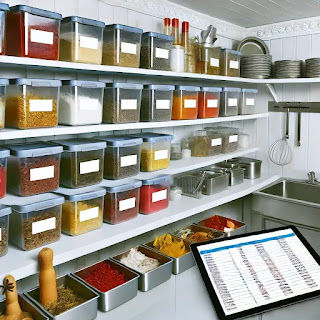Search This Blog
Dine to Success is your go-to resource for mastering the art of restaurant management. Whether you're a seasoned restaurant owner or just starting out, our blog provides actionable strategies and insights to help you boost efficiency, manage costs, motivate your team, and enhance customer experience.
Featured
- Get link
- X
- Other Apps
10 Essential Tips for Managing Restaurant Inventory Efficiently
Discover 10 essential tips for managing restaurant inventory efficiently. Boost profits and reduce waste with our expert guide. Start optimizing your inventory today!
Efficient restaurant inventory keeps costs in check and ensures that everything runs smoothly. This all-inclusive guide considers ten surefire tips to help you manage inventory seamlessly and reduce unnecessary wastage to give a fillip to the bottom line.
Introduction
For example: It's a busy Friday night, and your restaurant is fully booked, only to find out that you've run out of the main ingredient for your best-selling dish. Aside from losing sales, this situation also disappoints your very own loyal customers. Proper inventory management will help you avoid such situations and keep your restaurant running smoothly.
Efficient restaurant inventory management is not just about stock; it's also about taking care of resources, wasting less, and earning more. This article illustrates ten ways that will completely change how you do inventory management.
- Utilize a reliable system of tracking the inventories.
The backbone of any good inventory management is an inventory tracking system. It may be as advanced as software, or as simple as a high level of organization applied to a spreadsheet; in the best case, however, it's going to come down to consistency.
- Choose Your Software: Set up inventory management software for restaurants. Some of them offer real-time tracking, auto-replenishment, and integration with your POS system to save lots of time and avoid human errors.
- Periodic Updates: The inventory should be updated daily, reflecting sales, any new stock, and waste.
- Inventory Auditing on a Regular Basis
Regular audits take place whereby one can establish discrepancies between recorded and actual stock.
- Weekly Counts: Conduct the physical counts of high turnovers on a weekly basis.
- Monthly Audits: Inventory audits shall be performed monthly for all inventory items.
- Spot Checks: Make random checks of specific items to ensure their accuracy.
- Establish PAR Levels
Setting par helps to guarantee that you are never out of essential ingredients because par levels indicate the minimum amount of each item that must be in inventory.
- Calculate Based on Usage: The calculation of average usage rates provides a basis for determining appropriate par levels.
- Adjust Seasonally: Adjust par levels during peak seasons or special events.
- First-In, First-Out (FIFO) Method
Practice the FIFO method to minimize wasted items because of spoilage.
- Organize Stock Accordingly: Place newer stock behind older stock.
- Train Staff: Make sure that all staff is aware of and abides by the FIFO system.
- Monitor Supplier Performance
Your key suppliers have a great impact on efficiency in inventory.
- Reliability Appraisal: Periodically evaluate suppliers in respect of delivery times, quality, and level of accuracy.
- Negotiate Terms: Bulk discounts or flexible delivery schedules to maintain optimum inventory levels.
- Utilize Forecasting Tools
Accurate forecasting helps in planning inventory based on foreseen demand.
- Analyze Sales Data: The data from previous sales should be employed to forecast future needs.
- External Factors: Consider holidays, events at specific locations, and seasonal trends.
- Train Your Staff
Your team is key to any good inventory management.
- Inventory Training: Train the staff on inventory procedures, instilling the importance of precision therein.
- Assign Responsibilities: Clearly define the members who will handle inventory.
- Implement Waste Reduction Strategies
It directly improves your bottom line by reducing waste.
- Waste Mapping: Record all instances of waste to identify patterns.
- Optimize Menu: Work on your menu to have dishes that have a lot in common regarding ingredients.
- Leverage Technology
Technology can automate and streamline a lot of tasks related to inventory management.
- Integrate Systems: Make sure your POS, ordering, and inventory systems are talking to each other.
- Use Mobile Apps: With mobile apps, update your inventory and get alerts anytime, anywhere.
- Regularly review and refine your processes
Inventory management is not set in stone.
- Continual Improvement: Continuously monitor, and periodically review processes for areas of improvement.
- Stay up to date with industry trends and new technologies that increase efficiency.
Conclusion
Restaurant inventory management is both a dynamic and continuous process, efficiently requiring attention to details, the right kind of tools, and a proactive attitude. Applying these basic ten tips effectively will reduce your costs and waste while increasing customer satisfaction and profits.
Ready to take your restaurant to the next level? Then make sure to begin practicing these strategies today and see the difference they can make!For more in-depth guidance on creating a winning restaurant business plan, check out my comprehensive book: "The Ultimate Restaurant Success Handbook: Scaling, Managing, and Sustaining Long-Term Growth." available on Amazon: https://www.amazon.com/dp/B0DJQDVC12
This resource provides step-by-step instructions, real-world examples, and expert insights to help you create a business plan that sets your restaurant up for success. Don't start your culinary journey without it!
- Get link
- X
- Other Apps
Popular Posts
10 Proven Strategies for Efficient Stock Reordering and Waste Prevention in 2024
- Get link
- X
- Other Apps

Comments
Post a Comment